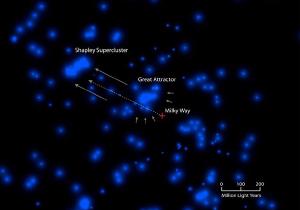Blog
Great Attractor
28 January 2014
There’s a region of space about 150 million light years away that is gravitationally attracting the galaxies in its region, including ours. It is known as the great attractor, and we’re not entirely sure what’s there. The problem is it happens to lie in the direction of the zone of avoidance, so our own galaxy is blocking our view.
When we measure the motion of our galaxy relative to other nearby galaxies, we find that the Milky Way is moving in the general direction of the great attractor at a speed of about 2.2 million kilometers per hour. Observations of other galaxies also indicated motion in that direction, which gave rise to idea that a large concentration of galaxies must exist within that region. But since the great attractor is within the zone of avoidance, it was difficult to determine what is there.
As I mentioned last time, the zone of avoidance is the region of sky where the plane of our galaxy is located. Because of the gas and dust in the plane it is difficult to see beyond our galaxy in that direction. But gas and dust obscure some wavelengths more than others. Radio, infrared and x-rays, for example, can penetrate the region more readily, so with the rise of astronomy at these wavelengths (particularly x-rays) we began map the region of the great attractor.
 IfA
IfABy the 1980s we were able to pin down the location of the great attractor, and found that it was centered at a large cluster of galaxies known as the Norma cluster. Later observations found that this region doesn’t have enough mass to be the sole source of the attraction. Instead a larger supercluster known as the Shapley supercluster. It contains about 10,000 Milky Way sized galaxies, and is the largest known supercluster in the visible universe. So now we have an understanding of the clusters pulling our galaxy.